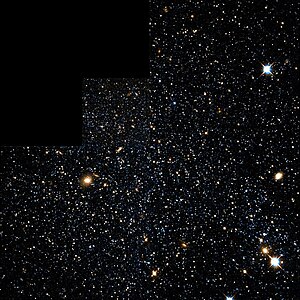| Revision as of 18:29, 25 June 2016 editJ 1982 (talk | contribs)Autopatrolled, Extended confirmed users153,041 edits →External links← Previous edit | Revision as of 09:20, 16 September 2016 edit undoTardigrade7 (talk | contribs)98 editsm Moved image to infoboxNext edit → | ||
| Line 1: | Line 1: | ||
| {{Infobox Galaxy | {{Infobox Galaxy | ||
| | image = ] | |||
| | image = | |||
| | caption= Phoenix Dwarf by the ] | |||
| | caption = | |||
| | name = Phoenix Dwarf | | name = Phoenix Dwarf Galaxy | ||
| | epoch = ] | | epoch = ] | ||
| | type = IAm<ref name="ned">{{cite web | | type = IAm<ref name="ned">{{cite web | ||
| Line 81: | Line 81: | ||
| | postscript = <!--None--> | | postscript = <!--None--> | ||
| |arxiv = astro-ph/0001040 }}</ref> | |arxiv = astro-ph/0001040 }}</ref> | ||
| ]]] | |||
| == References == | == References == | ||
Revision as of 09:20, 16 September 2016
| Phoenix Dwarf Galaxy | |
|---|---|
 Phoenix Dwarf by the Hubble Space Telescope Phoenix Dwarf by the Hubble Space Telescope | |
| Observation data (J2000 epoch) | |
| Constellation | Phoenix |
| Right ascension | 01 51 06.3 |
| Declination | −44° 26′ 41″ |
| Redshift | 60 ± 30 km/s |
| Distance | 1.44 ± 0.07 Mly (440 ± 20 kpc) |
| Apparent magnitude (V) | 13.1 |
| Characteristics | |
| Type | IAm |
| Apparent size (V) | 4′.9 × 4′.1 |
| Notable features | - |
| Other designations | |
| ESO 245- G 007, PGC 6830 | |
The Phoenix Dwarf is a dwarf irregular galaxy discovered in 1976 by Hans-Emil Schuster and Richard Martin West and mistaken for a globular cluster. It is currently 1.44 Mly away from Earth. Its name comes from the fact that it is part of the Phoenix constellation.
Characteristics
The Phoenix Dwarf has an inner part of young stars which is stretched in an east-west direction and an outer part of mainly old stars that is stretched north-south. The central region's rate of star formation seems to have been relatively constant across time (Martínez-Delgado et al. 1999). In 1999, St-Germain et al. discovered a H I region of about 10 M☉ just to the west of Phoenix. Its radial velocity is -23 km/s and may be physically associated with Phoenix if it is found to have a similar radial velocity.
References
- ^ "NASA/IPAC Extragalactic Database". Results for Phoenix Dwarf. Retrieved 2007-03-15.
- I. D. Karachentsev; V. E. Karachentseva; W. K. Hutchmeier; D. I. Makarov (2004). "A Catalog of Neighboring Galaxies". Astronomical Journal. 127 (4): 2031–2068. Bibcode:2004AJ....127.2031K. doi:10.1086/382905.
- Karachentsev, I. D.; Kashibadze, O. G. (2006). "Masses of the local group and of the M81 group estimated from distortions in the local velocity field". Astrophysics. 49 (1): 3–18. Bibcode:2006Ap.....49....3K. doi:10.1007/s10511-006-0002-6.
- Schuster, H.-E.; West, R. M. (May 1976). "A very distant globular cluster?". Astronomy & Astrophysics. 49: 129–131. Bibcode:1976A&A....49..129S.
- Canterna, R.; Flower, P. J. (March 1977). "A new dwarf irregular galaxy in the constellation Phoenix". Astrophysical Journal. 212 (Letters): L57 – L58. Bibcode:1977ApJ...212L..57C. doi:10.1086/182374.
- van den Bergh, Sidney (April 2000). "Updated Information on the Local Group". The Publications of the Astronomical Society of the Pacific. 112 (770): 529–536. arXiv:astro-ph/0001040. Bibcode:2000PASP..112..529V. doi:10.1086/316548.
External links
- The Phoenix Dwarf on WikiSky: DSS2, SDSS, GALEX, IRAS, Hydrogen α, X-Ray, Astrophoto, Sky Map, Articles and images
| Milky Way | |||||||
|---|---|---|---|---|---|---|---|
| Location | Milky Way → Milky Way subgroup → Local Group → Local Sheet → Virgo Supercluster → Laniakea Supercluster → Local Hole → Observable universe → Universe Each arrow (→) may be read as "within" or "part of". |  | |||||
| Structure |
| ||||||
| Satellite galaxies | |||||||
| Related | |||||||